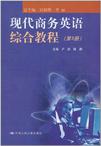现代商务英语综合教程(第5册)
出版时间:2011-4 出版社:中国人民大学出版社 作者:卢欣 等主编 页数:230
内容概要
《现代商务英语综合教程》的编写宗旨是:在遵循现代外语教学理念基础上,强调外语在商务领域中的应用,注重为学生创造商务环境。全面培养学生的英语综合应川能力,使他们在今后的下作中能用英语有效地进行口头和书面商务沟通。
书籍目录
CHAPTER 1 Basics of International Trade
Background Case
Listening
Reading
Structure
Vocabulary
Comprehension
Translation
Speaking
Writing
Additional Reading
CHAPTER 2 ImportExport Procedures
Background Case
Listening
Reading
Structure
Vocabulary
Comprehension
Translation
Speaking
Writing
Additional Reading
CHAPTER 3 Trade Negotiation
Background Case
Listening
Reading
Structure
Vocabulary
Comprehension
CHAPTER 4 Trade Payment
CHAPTER 5 Transport and lnsurance
CHAPTER 6 Countertrade
CHAPTER 7 Trade Fairs
CHAPTER 8 E-Business
CHAPTER 9 Technology
CHAPTER 10 Business Law
CHAPTER 11 Cultural Diversity
CHAPTER 12 The Future of Business
章节摘录
Ghanas inward-oriented tradepolicy resulted in a shift of resources awayfrom the profitable activity of growingcocoa, where it had an absolute advantagein the world economy, toward growingsubsistence foods and manufacturing,where it had no advantage. This inefficientuse of the countrys resources severelydamaged the Ghanaian economy and heldback the countrys economic development. In contrast, consider the tradepolicy adopted by the South Koreangovernment. The World Bank hascharacterized the trade policy of SouthKorea as strongly outward-oriented.Untike in Ghana, the policies of theSouth Korean government emphasizedlow import barriers on manufacturedgoods (but not on agricultural goods) andincentives to encourage South Koreanfirms to export. Beginning in the late1950s,. the South Korean governmentprogressively reduced import tariffs froman average of 60 percent of the price of animported good to less than 20 percent inthe mid-1980s. On most nonagriculturalgoods, import tariffs were reduced to zero.In addition, the number of imported goodssubject to quotas was reduced from morethan 90 percent in the late 1950s to zeroby the early 1980s. Over the same period,South Korea progressively reduced thesubsidies given to South Korean exportersfrom an average of 80 percent of theirsales price in the late 1950s to an averageof less than 20 percent in 1965, and downto zero in 1984. With the exception of theagricultural sector (where a strong farmlobby maintained import controls), SouthKorea moved progressively toward a freetrade stance.
图书封面
评论、评分、阅读与下载
用户评论 (总计2条)
- 很不错,配合着参考书用挺有效果
- 書不錯,可是就是沒答案
推荐图书
- 中文版PowerPoint 2003七日速成
- 国家赔偿
- 东固革命根据地简史
- 明清时期珠江三角洲区域史研究
- 瓢虫小仙女系列·学游泳的鳄鱼
- 孤独的狗熊
- 魔法电视台
- 仙女魔法赛
- 瓢虫小仙女系列·想要识字的驴子
- 瓢虫小仙女系列·蜗牛的幸福屋
- 想变成巫婆的奶牛
- 漫画南传《法句经》
- 瓢虫小仙女系列·树上有一只小野猪
- 瓢虫小仙女系列·大鼻子考拉
- 他不爱我
- 贺友直自说自画
- lily的女性塗鴉牆
- もう一つの出会い
- 文明小史
- 荒弃的家园
- 精选宋词与宋画(西汉对照)Poesía y Pintura de la Dinastía Tang——Antología Selecta
- 武蔵 円明の光
- 心灵花园
- 神楽坂の仇討ち
- 巧克力天使
